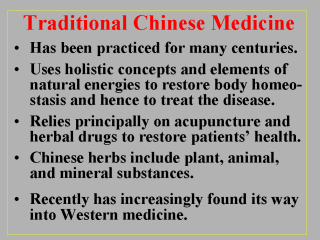| front |1 |2 |3 |4 |5 |6 |7 |8 |9 |10 |11 |12 |13 |14 |15 |16 |17 |18 |19 |20 |21 |22 |23 |review |
 |
As stated
earlier, traditional Chinese medicine (TCM) has been practiced in China for centuries. It
relies upon countless generations of holistic concepts, empirical observations, and human
experiments. The holistic concepts so used include principally (but are not limited to)
the theory of Ying-Yang, the vital force of life Qi, and the five elements
of natural energies Metal, Wood, Water, Fire, and Earth.
The applications of these holistic theories and elements are rather difficult to
characterize or be translated into another language; and their discussion is beyond the
scope of this lecture. For those who are interested in these theories and elements in
English, they are referred to such excellent books by Chmelik (1999), Fan (1996), Naeser
(1993), and many more. In a nutshell, TCM treats the patientís whole body and the cause of the disease, rather than the disease per se. In addition to the more recent use of acupuncture, it relies on principally herbal drugs to restore patientsí health and to maintain their body homeostasis. Chinese herbal medicines include the use of plant, animal, and mineral substances. According to the Chinese Herbal Pharmacopeia (Materia Medica), Chinese herbs include everything from fresh leaves and berries, to the more surprising scorpion tails. In recent years, TCM has increasingly found its way into Western medicine, in part because it has offered specific cures not found in the latter. In China, many hospitals increasingly employ acupuncture anesthesia and herbal recovery to aid surgery performed with Western technology, although many other clinics still rely on traditional healing modalities. |